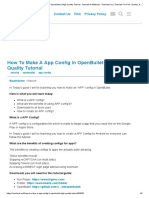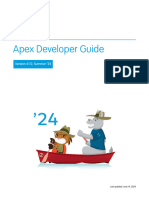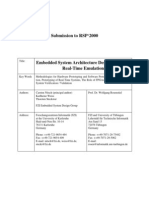Chapter - 3 Requirement Specification: 3.1 Functional Requirements
Chapter - 3 Requirement Specification: 3.1 Functional Requirements
Uploaded by
Suraj BahadurCopyright:
Available Formats
Chapter - 3 Requirement Specification: 3.1 Functional Requirements
Chapter - 3 Requirement Specification: 3.1 Functional Requirements
Uploaded by
Suraj BahadurOriginal Description:
Original Title
Copyright
Available Formats
Share this document
Did you find this document useful?
Is this content inappropriate?
Copyright:
Available Formats
Chapter - 3 Requirement Specification: 3.1 Functional Requirements
Chapter - 3 Requirement Specification: 3.1 Functional Requirements
Uploaded by
Suraj BahadurCopyright:
Available Formats
Chapter – 3
Requirement Specification
3.1 Functional Requirements
A functional requirement defines a function of a software-system or its component. A
function is described as a set of inputs, the behavior, Firstly, the system is the first that
achieves the standard notion of semantic security for data confidentiality in attribute-based
deduplication systems by resorting to the hybrid cloud architecture.
3.2 Non-Functional Requirements
Our multi-modal event tracking and evolution framework is suitable for multimedia
documents from various social media platforms, which can not only effectively capture their
multi-modal topics, but also obtain the evolutionary trends of social events and generate
effective event summary details over time. Our proposed mmETM model can exploit the
multi-modal property of social event, which can effectively model social media documents
including long text with related images and learn the correlations between textual and visual
modalities to separate the visual-representative topics and non-visual-representative topics.
3.3 Hardware Requirements
The hardware requirements may serve as the basis for a contract for the
implementation of the system and should therefore be a complete and consistent specification
of the whole system. They are used by software engineers as the starting point for the system
design. It shows what the system do and not how it should be implemented.
PROCESSOR : Intel i5.
RAM : 4GB RAM
HARD DISK : 500 GB
3.4 Software Requirements
The software requirements document is the specification of the system. It should include both
a definition and a specification of requirements. It is a set of what the system should do rather
than how it should do it. The software requirements provide a basis for creating the software
requirements specification. It is useful in estimating cost, planning team activities,
performing tasks and tracking the teams and tracking the team’s progress throughout the
development activity.
Operating System : Windows 10
IDE/Editor : Anaconda / Spyder3
Programming Language : Python
Anaconda navigator is an open source distributor for Python. It focuses on providing
IDE’s and programming environments for data science and machine learning. Anaconda is
widely used because of the custom packages that have been built. It is compatible with
Windows, Linux and MacOS. Anaconda also supports development in R programming and
has a wide community base surround in the development in R and python development.
The neural networks built on in this project were completed using the Keras libraries.
Keras offers neural network API which can run on Tensorflow or Theano. Keras was selected
for its user-friendly API’s and its ability to support multiple CPU’s as well as GPU’s. Keras
facilitates seamless prototyping. Like all python libraries Keras also takes advantages of the
modularity concept providing users with independent configurable modules. These modules
are also customizable allowing the developers to create new and more effective model to suit
their requirements. Since all the code is purely written in python, python developers do not
find it hard to debug or run complex modified code.
3.5 Feasibility Study
A feasibility study is a detailed analysis of a system and its operations that is
conducted in order to predict the results of a specific future course of action. A feasibility
study is conducted in anticipating an important strategic decision. For example, to evaluate a
performance of the proposed system and its impact when major changes are made.
"Conduct a feasibility study to start the course of action,". It will provide you with objective
information to evaluate existing systems services and strengths. The feasibility study will
help accurately anticipate what will and will not work in varied situations.
Feasibility study is categorized as follows:
Technology and System feasibility
Economic feasibility
Operational feasibility
Technology and System feasibility: The assessment is based on an outline design of system
requirements in terms of Input, Processes, Output, Programs, and Procedures.
Economic feasibility: Economic analysis is the most frequently used method for evaluating
the effectiveness of a new system. This is commonly known as cost/benefit analysis. As the
proposed system is build using open source software like python, their cost is considered to
be
cost effective
Operational feasibility: The proposed system saves the battery power of the clients with a
little delay by utilizing the multiple channels. The algorithm can be easily adapted to the
heterogeneous environments.
You might also like
- How To Make A App Config in Openbullet - High Quality TutorialDocument3 pagesHow To Make A App Config in Openbullet - High Quality TutorialSuraj Bahadur100% (2)
- Salesforce Apex Developer GuideDocument742 pagesSalesforce Apex Developer GuideprintableboonNo ratings yet
- CS2301 SOFTWARE ENGINEERING - Important Questions With Answers PDFDocument14 pagesCS2301 SOFTWARE ENGINEERING - Important Questions With Answers PDFlucifer100% (5)
- What Is Virtual Credit Card?Document6 pagesWhat Is Virtual Credit Card?Suraj Bahadur76% (34)
- Crime Records Management System A ASP - Net ProjectDocument101 pagesCrime Records Management System A ASP - Net ProjectDeepak Kumar60% (10)
- Let's Dig In!: 1. The Easy WayDocument5 pagesLet's Dig In!: 1. The Easy WaySuraj Bahadur0% (1)
- HOW TO GET FREE RDP - NEW METHOD June 2020 - Tutorials & Methods - OneHack - Us - Tutorials For Free, Guides, Articles & Community Forum PDFDocument2 pagesHOW TO GET FREE RDP - NEW METHOD June 2020 - Tutorials & Methods - OneHack - Us - Tutorials For Free, Guides, Articles & Community Forum PDFSuraj BahadurNo ratings yet
- 407 - UNIT 1 Android Developer FundamentalsDocument310 pages407 - UNIT 1 Android Developer FundamentalsNabillah PuspitaNo ratings yet
- Vehich Store ProjectDocument47 pagesVehich Store ProjectkapilNo ratings yet
- Python SampleDocument39 pagesPython SampleMidhun ManojNo ratings yet
- Software Requirement Specification On: Prison Management SystemDocument37 pagesSoftware Requirement Specification On: Prison Management SystemSEENU MANGALNo ratings yet
- Project e BillingDocument20 pagesProject e BillingLokanath ChoudhuryNo ratings yet
- Office File Management SystemDocument44 pagesOffice File Management SystematozdhiyanesNo ratings yet
- Exam NotesDocument27 pagesExam NotesAbdighaniMOGoudNo ratings yet
- Homework 3Document10 pagesHomework 3Preet AroraNo ratings yet
- Project Report On Airlines Reservation SystemDocument35 pagesProject Report On Airlines Reservation SystemShivam MishraNo ratings yet
- Chapter Four WAREHOUSEDocument7 pagesChapter Four WAREHOUSEToyeebNo ratings yet
- Embedded Systems Architecture: Design and write software for embedded devices to build safe and connected systemsFrom EverandEmbedded Systems Architecture: Design and write software for embedded devices to build safe and connected systemsNo ratings yet
- Asansol Engineering College: Topic: PPT Assignment On "Introduction To Software Engineering"Document15 pagesAsansol Engineering College: Topic: PPT Assignment On "Introduction To Software Engineering"Haimanti SadhuNo ratings yet
- Unit 3 NotesDocument9 pagesUnit 3 NotesvivekNo ratings yet
- ContentDocument12 pagesContentganashreep2003No ratings yet
- Software Engr HandbkDocument21 pagesSoftware Engr HandbkEboka ChukwukaNo ratings yet
- Unit 5 - SoftwareDocument8 pagesUnit 5 - SoftwareAbhay GuptaNo ratings yet
- Requirement Analysis and SpecificationDocument32 pagesRequirement Analysis and Specificationsuresh mpNo ratings yet
- Unit 5 - Software ArchitectureDocument6 pagesUnit 5 - Software ArchitectureLucky KanatheNo ratings yet
- 2 - Sitd109 - Program Design and DevelopmentDocument2 pages2 - Sitd109 - Program Design and DevelopmentMoses OkumuNo ratings yet
- 1 ExpDocument4 pages1 ExpSanchit KumarNo ratings yet
- 1Document21 pages1Gopinath SamyduraiNo ratings yet
- Index: S.No Content Page No. RemarksDocument17 pagesIndex: S.No Content Page No. RemarksAnil SharmaNo ratings yet
- Attendance Management System OriginalDocument95 pagesAttendance Management System OriginalSangeetha BalakrishnanNo ratings yet
- DOCCUMENTDocument49 pagesDOCCUMENTpriyanka_gadeNo ratings yet
- HCSSDocument114 pagesHCSSKhaja HussainNo ratings yet
- Se PDFDocument2 pagesSe PDFAnuj HandeNo ratings yet
- Unit - 3 Software DesignDocument60 pagesUnit - 3 Software DesignIshwariyaNo ratings yet
- 6ed Solutions Chap06Document15 pages6ed Solutions Chap06JesseSpero100% (2)
- Chapter 6 - Review QuestionsDocument6 pagesChapter 6 - Review QuestionsCharis Marie UrgelNo ratings yet
- Software Engineering Question BankDocument7 pagesSoftware Engineering Question Banksubhapam100% (1)
- L. 1-8Document152 pagesL. 1-8Bhanu Prakash100% (1)
- L4 Backend DesignDocument44 pagesL4 Backend DesignngenderanjNo ratings yet
- Project Synopsis "University Management System"Document50 pagesProject Synopsis "University Management System"vikas royNo ratings yet
- Lab Reports On Case StudyDocument22 pagesLab Reports On Case StudyNeha SinghNo ratings yet
- Software Engineering Assignment 1Document12 pagesSoftware Engineering Assignment 1Husanpreet SinghNo ratings yet
- Architecture Compliance Review ChecklistDocument10 pagesArchitecture Compliance Review ChecklistEdwin MbogoNo ratings yet
- (SwSE) Software Systems EngineeringDocument36 pages(SwSE) Software Systems EngineeringGabriel StoicaNo ratings yet
- Chapter-2 System Requirement Analysis and Project ManagementDocument8 pagesChapter-2 System Requirement Analysis and Project Managementgattus123No ratings yet
- Theoretical Background of The ProjectDocument79 pagesTheoretical Background of The Projectnageshcool75% (4)
- ChatbotDocument41 pagesChatbotAPCACNo ratings yet
- StaffDocument50 pagesStaffvarunNo ratings yet
- Unit 02Document53 pagesUnit 02Kamini SalunkheNo ratings yet
- Sheet 3 SolutionDocument4 pagesSheet 3 SolutionFarah Alaa el Din Hassan KattabNo ratings yet
- CC105 ReviewerDocument7 pagesCC105 ReviewerMark James Dela CruzNo ratings yet
- Approach For Mis DesignDocument22 pagesApproach For Mis DesignSudhir Bodduluri50% (2)
- Chapter 2Document9 pagesChapter 2Rishika EllappanNo ratings yet
- Software Engineering Unit-1 NotesDocument30 pagesSoftware Engineering Unit-1 NotesQutubkhan KheraluwalaNo ratings yet
- M06 - Configure & Administer ServerDocument188 pagesM06 - Configure & Administer ServerAyansa ErgibaNo ratings yet
- Notes ITBDocument11 pagesNotes ITBvigneshmvicky2628No ratings yet
- seDocument5 pagesseArjun BansalNo ratings yet
- PROJECT-library C++Document22 pagesPROJECT-library C++Lokanath Choudhury0% (1)
- Timetablegeneratror ContentsDocument46 pagesTimetablegeneratror ContentsAnchu LalNo ratings yet
- Module 8Document11 pagesModule 8efrenNo ratings yet
- Embed DesignDocument9 pagesEmbed Designjanakiram473No ratings yet
- Introduction To Software Engineering: Chapter-1Document112 pagesIntroduction To Software Engineering: Chapter-1Janabhawana CampusNo ratings yet
- CH 1234 Summaries SEDocument13 pagesCH 1234 Summaries SEomarobeidd03No ratings yet
- The Software Programmer: Basis of common protocols and proceduresFrom EverandThe Software Programmer: Basis of common protocols and proceduresNo ratings yet
- Software Testing Interview Questions You'll Most Likely Be AskedFrom EverandSoftware Testing Interview Questions You'll Most Likely Be AskedNo ratings yet
- Create An Account On - Go To Your Dashboard Go To Your ProfileDocument3 pagesCreate An Account On - Go To Your Dashboard Go To Your ProfileSuraj BahadurNo ratings yet
- How To Hack Facebook Accounts - New Methods (Another Highly Detailed Tutorial) PDFDocument6 pagesHow To Hack Facebook Accounts - New Methods (Another Highly Detailed Tutorial) PDFSuraj BahadurNo ratings yet
- Project Based Learning: Predicting Bitcoin Prices Using Deep LearningDocument24 pagesProject Based Learning: Predicting Bitcoin Prices Using Deep LearningSuraj BahadurNo ratings yet
- 100+ Java Edureka 1Document10 pages100+ Java Edureka 1Suraj BahadurNo ratings yet
- 100+ Java Edureka 2Document4 pages100+ Java Edureka 2Suraj BahadurNo ratings yet
- Chapter - 1: 1.1 ObjectivesDocument3 pagesChapter - 1: 1.1 ObjectivesSuraj BahadurNo ratings yet
- Azure AZ-900 Exam Preparation Guide - How To Pass in 3 DaysDocument12 pagesAzure AZ-900 Exam Preparation Guide - How To Pass in 3 DaysSuraj BahadurNo ratings yet
- Chapter - 1: 1.1 ObjectivesDocument7 pagesChapter - 1: 1.1 ObjectivesSuraj BahadurNo ratings yet
- A Mini Project Report On: Power Management System For Highways Using SensorsDocument4 pagesA Mini Project Report On: Power Management System For Highways Using SensorsSuraj BahadurNo ratings yet
- Chapter - 1: 1.1 ObjectivesDocument35 pagesChapter - 1: 1.1 ObjectivesSuraj BahadurNo ratings yet
- Project Based Learning: Predicting Bitcoin Prices Using Deep LearningDocument8 pagesProject Based Learning: Predicting Bitcoin Prices Using Deep LearningSuraj BahadurNo ratings yet
- Graduation Project Online Management System ALHOSNDocument9 pagesGraduation Project Online Management System ALHOSNmanigandanNo ratings yet
- C2000™ MCU 1-Day Workshop: Workshop Guide and Lab ManualDocument118 pagesC2000™ MCU 1-Day Workshop: Workshop Guide and Lab ManualSoheil GhassempoorNo ratings yet
- Avr031: Getting Started With Imagecraft C For Avr: 8-Bit Microcontroller Application NoteDocument8 pagesAvr031: Getting Started With Imagecraft C For Avr: 8-Bit Microcontroller Application Notecarlos augusto do carmo braiaNo ratings yet
- Finally Letting The Developers Develop: Solving The 70/30 Dev Problem With Openshift Container PlatformDocument10 pagesFinally Letting The Developers Develop: Solving The 70/30 Dev Problem With Openshift Container PlatformJozsefPuczNo ratings yet
- JAX-WS - Get Workers TutorialDocument10 pagesJAX-WS - Get Workers TutorialEdgar GaloisNo ratings yet
- M1 - Lab 1 CSDocument5 pagesM1 - Lab 1 CSBilal MaqsoodNo ratings yet
- Chapter 2 Intoduction Visual ProgrammingDocument66 pagesChapter 2 Intoduction Visual ProgrammingFaz1999 FaNo ratings yet
- Python For Data Science Department of Computer Science and Engineering Indian Institute of Technology, Madras Lecture - 02 Introduction To PythonDocument18 pagesPython For Data Science Department of Computer Science and Engineering Indian Institute of Technology, Madras Lecture - 02 Introduction To PythonVeera PandianNo ratings yet
- Python 101Document295 pagesPython 101Rodolfo Silva100% (3)
- OpenSAP Portal1 Week 1 ExerciseDocument19 pagesOpenSAP Portal1 Week 1 ExerciseNanda Najah MaiaNo ratings yet
- Manual For Data and BooksDocument18 pagesManual For Data and Bookskennethwong45No ratings yet
- Tutorial TinyeditorDocument28 pagesTutorial TinyeditorjerinconNo ratings yet
- Annamalai UniversityDocument45 pagesAnnamalai UniversityGreen ZoneNo ratings yet
- SadDocument276 pagesSadnrajesh8383No ratings yet
- NurturHub - Final Report WITH STPDocument49 pagesNurturHub - Final Report WITH STP20ai039.prathamNo ratings yet
- Prizm Programming GuideDocument168 pagesPrizm Programming GuideBucur MateiNo ratings yet
- Android App For Household Services: © June 2021 - IJIRT - Volume 8 Issue 1 - ISSN: 2349-6002Document6 pagesAndroid App For Household Services: © June 2021 - IJIRT - Volume 8 Issue 1 - ISSN: 2349-6002marlon hypeNo ratings yet
- How-To Install Android SDK On Windows, Mac and LinuxDocument15 pagesHow-To Install Android SDK On Windows, Mac and LinuxSalman1231100% (1)
- FPT CV HiepLH10-Developer-1Document4 pagesFPT CV HiepLH10-Developer-1Nguyen Minh TuanNo ratings yet
- Rstudio IdeDocument2 pagesRstudio IdeFlorence CheangNo ratings yet
- COMP 202 SyllabusDocument9 pagesCOMP 202 SyllabusJake ZhuNo ratings yet
- Documentation For Installing ESP8266 Arduino CoreDocument4 pagesDocumentation For Installing ESP8266 Arduino CoreFrugal Labs - Digital LearnNo ratings yet
- (Iot Based Smart Refueling System) : (Mid-Point Report)Document40 pages(Iot Based Smart Refueling System) : (Mid-Point Report)nadeeshanNo ratings yet
- Visual Studio Code: Getting StartedDocument69 pagesVisual Studio Code: Getting StartedguskarismaNo ratings yet
- Nagendra Salesforce Developer .Document10 pagesNagendra Salesforce Developer .KIRAN KIRANNo ratings yet
- Lecture 01 - Programming FundamentalsDocument28 pagesLecture 01 - Programming FundamentalsSaad QayyumNo ratings yet
- Robotics, PPTDocument31 pagesRobotics, PPT22nu5a0415No ratings yet
- RStudio IDEDocument8 pagesRStudio IDEravi kiranNo ratings yet








































































































